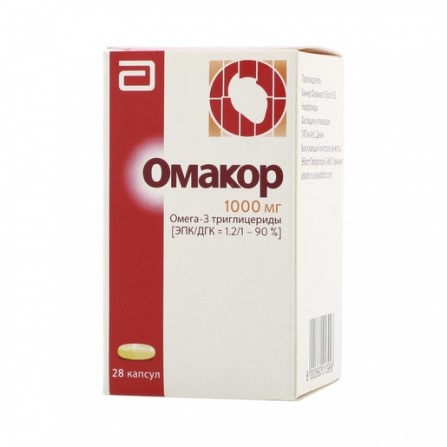More info
Active ingredients
Omega-3 triglycerides (EPA / DHA = 1.2 / 1-90%)
Release form
Capsules
Composition
Active ingredient: Ethyl esters of omega-3 fatty acids Concentration of the active substance (mg): 1000
Pharmacological effect
Lipid-lowering agent. Polyunsaturated fatty acids of the omega-3 class - eicosapentaenoic acid (EPA) and docosahexaenoic acid (DHA) - are essential (essential) fatty acids (NEFA). Reduces the concentration of triglycerides as a result of a decrease in the concentration of VLDL, in addition, actively affects blood pressure and hemostasis , reducing the synthesis of thromboxane A2 and slightly increasing the clotting time of the blood. No significant effect on other coagulation factors was observed. Delays the synthesis of triglycerides in the liver (by inhibiting the esterification of EPA and DHA). Reducing the concentration of triglycerides contributes to the increase in peroxisome beta-oxidation of fatty acids (reducing the amount of free fatty acids available for the synthesis of triglycerides). Inhibition of this synthesis reduces the level of VLDL. Increases the level of LDL cholesterol in some patients with hypertriglyceridemia. Increasing the concentration of HDL is minimal and significantly lower than after taking fibrates.
Pharmacokinetics
During and after absorption in the small intestine of fatty acids of the omega-3 class, there are 3 main ways of their metabolism: fatty acids are first delivered to the liver, where they are included in various categories of lipoproteins and sent to peripheral lipid stores; cell membrane phospholipids are replaced by lipoprotein phospholipids, after which fatty acids can act as precursors of various eicosanoids; most fatty acids are oxidized to meet energy needs. The concentration of omega-3 class fatty acids (EPA and DHA) in blood plasma phospholipids corresponds to the concentration of these fatty acids that are included in cell membranes.
Indications
Hypertriglyceridemia.
Contraindications
Hypersensitivity to the active substance, auxiliary substances. Age up to 18 years. Pregnancy and breastfeeding period.
Precautionary measures
Do not exceed recommended doses.
Use during pregnancy and lactation
There are no clinical data on the use during pregnancy. It should be used with pregnancy only after careful assessment of the risk-benefit ratio, when the expected benefit of therapy for the mother outweighs the potential risk to the fetus. Use during breastfeeding is contraindicated. If necessary, use during lactation, breastfeeding should be canceled.
Dosage and administration
Inside, during a meal in order to avoid the development of adverse events from the gastrointestinal tract.
Side effects
Hypersensitivity, hyperglycemia, dizziness, dysgeusia, headache, hypotension, dry nasal mucosa, dyspepsia, nausea, upper abdominal pain, gastrointestinal disturbances (gastroesophageal reflux, belching, vomiting, meteorism, diarrhea, gastroesophageal reflux, belching, vomiting, meteorism, diarrhea , acne, rash with itching, urticaria.
Overdose
No cases of drug overdose have been reported.
Interaction with other drugs
With simultaneous use with oral anticoagulants and other drugs that affect hemostasis, the risk of increased bleeding time increases. Simultaneous use with warfarin does not lead to any hemorrhagic complications. However, when combined with warfarin or in case of discontinuation of the course of treatment with this agent, MHO control is necessary.
special instructions
It should be used with caution in elderly patients (older than 70 years), with abnormal liver function, concurrently taken with oral anticoagulants, with fibrates, hemorrhagic diathesis, with severe injuries, surgical operations (due to the risk of increased bleeding time). Experience with secondary endogenous hypertriglyceridemia is limited (especially when uncontrolled diabetes mellitus). Due to the moderate increase in bleeding time (when used in high doses), patient monitoring is required and those with violations of the blood coagulation system, as well as receiving anticoagulant therapy or drugs that affect the hemostasis system (acetylsalicylic acid as an antiplatelet agent, NSAIDs), and if necessary, an appropriate dose adjustment of the anticoagulant or agents that affect the hemostasis system. Some patients showed an increase in the activity of ACT and ALT (within the normal range), while there are no data indicating an increased risk of using this drug in patients with impaired function cheni.There is a need to control the activity of ACT and ALT in patients with signs of abnormal liver function (especially when used in high doses). Effect on the ability to drive vehicles and control mechanisms potentially hazardous activities that require increased concentration of attention and quickness of psychomotor reactions.





